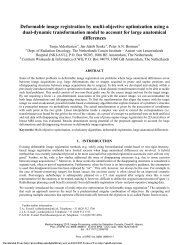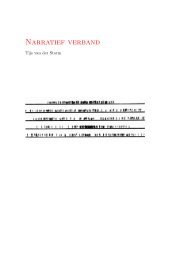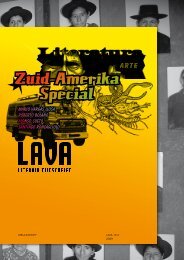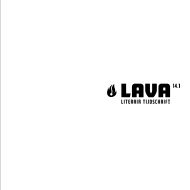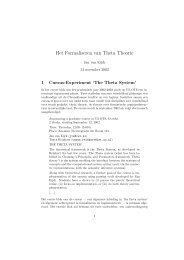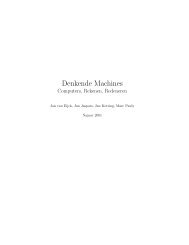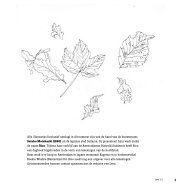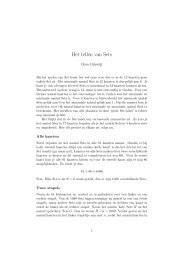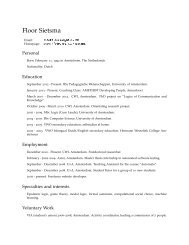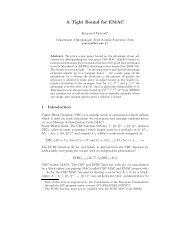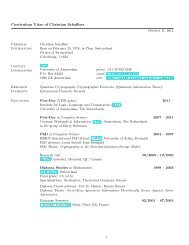Towards Multilingual Programming Environments - CWI
Towards Multilingual Programming Environments - CWI
Towards Multilingual Programming Environments - CWI
You also want an ePaper? Increase the reach of your titles
YUMPU automatically turns print PDFs into web optimized ePapers that Google loves.
<strong>Towards</strong> <strong>Multilingual</strong> <strong>Programming</strong> <strong>Environments</strong><br />
Tijs van der Storm, Jurgen Vinju<br />
<strong>CWI</strong>, Amsterdam<br />
Abstract<br />
Software projects consist of different kinds of artifacts: build files, configuration files, markup files, source<br />
code in different software languages, and so on. At the same time, however, most integrated development<br />
environments (IDEs) are focused on a single (programming) language. Even if a programming environment<br />
supports multiple languages (e.g., Eclipse), IDE features such as cross-referencing, refactoring, or<br />
debugging, do not often cross language boundaries. What would it mean for programming environment<br />
to be truly multilingual? In this short paper we sketch a vision of a system that integrates IDE support<br />
across language boundaries. We propose to build this system on a foundation of unified source code models<br />
and metaprogramming. Nevertheless, a number of important and hard research questions still need to be<br />
addressed.<br />
Keywords:<br />
<strong>Programming</strong> environments, language interoperability, metaprogramming<br />
<strong>Programming</strong> environments are an important thread through Paul’s research career. From the<br />
early papers on the ASF+SDF Meta-Environment to the Rascal programming language of today,<br />
a constant focus of Paul’s work has been to improve the life of the programmer with better tools,<br />
better designs, and better languages. In the meantime the software landscape has only become<br />
more complex, more heterogeneous and more multi-faceted. This short paper envisions a programming<br />
environment that both embraces and unifies this multiplicity using one of Paul’s favorite<br />
topics: metaprogramming. Thanks Paul, for our professional careers and for your friendship.<br />
We hope you enjoy reading this paper.<br />
1. Introduction<br />
Most software projects consist of many kinds of different artifacts, in different languages. For instance, a<br />
typical Java Web application project might contain Java source files, templates (e.g., JSP), Javascript source<br />
files, SQL schema definitions, ORM mapping files, and HTML templates. All these artifacts are related to<br />
each other. They may refer to each other through special names. For instance, class names coincide with<br />
database tables and HTML templates refer to tag libraries. Generally IDEs do not take the inter-operation<br />
of these languages into account; the reference links are not explicitly modeled, and thus not actionable, but<br />
they do exist in the code base. As a result, supporting features such as cross-referencing, refactoring, and<br />
debugging do not cross linguistic boundaries. This leads to inaccurate support which eventually leads to<br />
bugs that must be resolved later.<br />
Another source of language multiplicity is the meta information that is necessary to build, configure and<br />
deploy projects: build files (e.g., Ant, Maven), configuration files (e.g., Spring XML files). These languages<br />
seem secondary, but they have big impact on the semantics of the eventually running program, and as such<br />
may contain bugs. More problematically, language support for the other languages (such as Java) does<br />
not model most of the information in this meta data, introducing inaccuracy in IDE features such as quick<br />
URL: storm@cwi.nl (Tijs van der Storm), jurgenv@cwi.nl (Jurgen Vinju)<br />
Preprint submitted to Science of Computer <strong>Programming</strong> September 11, 2013
lookup, flow graphs and autocomplete. The more frameworks that offer reuse and high levels of abstraction<br />
are introduced, the harder it becomes to provide meaningful IDE features.<br />
Language referencing and meta information are just two examples of relations between languages. Other<br />
relations between languages include containment, where one language is embedded in another (e.g., SQL in<br />
COBOL code), — or derivation where one language is compiled into another language (e.g., code generation<br />
of a DSL). We expect truly multilingual IDEs to take all of these relations into account.<br />
Common IDEs like Eclipse provide IDE support for some of these languages and some of their combinations.<br />
They are, however, primarily targeted at a single programming language and there exists ample<br />
opportunity for further integration. For instance, Eclipse is mainly an IDE for Java. The plugin system of<br />
Eclipse allows users to get IDE support for other languages, such as JavaScript, XML, SQL, etc. However,<br />
such plugins are mostly isolated from each other: integration across language boundaries is limited. Often,<br />
each language lives in its own silo. As a result, the programmer constantly has to switch perspectives and<br />
mentally keep the different artifacts in sync.<br />
In this paper we analyze this problem in some depth and propose an approach to overcome these limitations.<br />
The key aspect of our design is to consider the multiplicity of languages as a federation of languages.<br />
Only the combination of all artifacts leads to the software system captured by the project, — in a sense<br />
there is only one big, composite language. Understanding a software project thus means understanding how<br />
these languages work together. Consequently, we hope, truly multilingual IDE support will be instrumental<br />
in improving understanding and thus in helping to construct and maintain high quality software.<br />
2. <strong>Towards</strong> monolingual programming environments, redux<br />
Heering and Klint wrote “<strong>Towards</strong> monolingual programming environments” in 1985 [8], warning us for<br />
the complexity of the exploding number of languages in programming environments and proposing to fully<br />
reverse this development into a single language with a single and consistent programming and debugging<br />
environment. Today we are faced with what we were warned for: hundreds of independent languages for<br />
programming, scripting, configuring, defining, and debugging software. Moreover, due to the availability of<br />
memory and disk space, we now have all these languages installed and active within the same computer<br />
system. For the sake of argument, let us assume this complex reality was introduced for all good reasons.<br />
In this paper we propose to view the de facto multiplicity of languages that a programmer is subjected<br />
to as a single, federated language. This federation of languages encompasses all kinds of “source code in<br />
the broad sense” [18]. What is the syntax of this language? What is its semantics? How do we model<br />
name resolution, declarations, uses, control flow, data flow, and types for this language? Given answers to<br />
these questions, we will have a principled method of modeling cross language semantic dependency. On top<br />
of such generic models, advanced IDE features such as refactoring tools, debugging, hover help, reference<br />
hyperlinks and auto-complete may be constructed. We propose a high level design and a research agenda<br />
towards integrated, multi-lingual development environments.<br />
2.1. One IDE to rule them all<br />
Here we describe the high-level requirements for enabling the syntactic and semantic integration of IDE<br />
support for multiple software languages. This design acts as a frame of reference for identifying the open<br />
problems that we discuss in Section 3.<br />
Uniform representation. At a very basic level language artifacts are a form of structured data. To allow this<br />
data to be processed in a typed and uniform way, requires three meta-level services. First, the structure of<br />
the data should be modeled in a uniform way, for instance using meta modeling, data description, or schema<br />
language. Second, the data itself should have a uniform, typed in-memory representation. Finally, a typed<br />
serialization/deserialization service is needed to load the language artifacts to/from disk.<br />
2
Uniform identification. Artifacts and sub-entities of those artifacts often have an identity to be able to refer<br />
to them. When a project consists of multiple languages, there are multiple meta models at play. Through<br />
the uniform representation the artifacts can be processed in a uniform way. However, each language might<br />
provide specific ways of identifying entities. To refer to elements from different languages in a uniform way<br />
we need a generic identification mechanism that works for all of them.<br />
Modeling relations. There are many examples of possible relations between artifacts and relations between<br />
sub-artifact elements: containment, call graphs, use-define relations, import relations, control-flow and data<br />
flow graphs, inheritance relations etc. It should be possible to super-impose such relations on top of the<br />
uniform representation of the artifacts. The generic identification mechanism plays a key role here.<br />
Hooks into the user interface. The analyses and transformations realized on top of the uniform representations<br />
of artifacts and the relations between them should be made available to the programmer through user<br />
interface affordances. The key requirement, however, is that the interface is language parametric. It should<br />
be possible to, for instance, provide syntax coloring for a language without having to customize the IDE per<br />
language. The same holds for invoking refactorings, hyperlinking artifacts, creating outlines etc.<br />
2.2. From reverse engineering to forward engineering<br />
The idea of generic language interoperability, composition or integration is not new. Especially in the<br />
fields of re-engineering and reverse engineering it was recognized earlier that software projects have to<br />
deal with language multiplicity. To be able to understand a software system, one must understand all of<br />
its components and both their implicit and explicit dependencies. At first, only uniform fact exchange<br />
formats [22, 12], explicitly modeled relations [11] and programmable visualizations [23] existed to conquer<br />
this challenge. More depth to this was added by explicitly analyzing other forms of source code, such as<br />
databases schemas [3], and configuration files.<br />
In particular, Yazdanshenas and Moonen used the concept of system dependence graphs (SDG), to model<br />
cross language dependency and make these dependencies actionable [38, 37]. Perin extended the Moose system<br />
for architectural reconstruction supporting cross language modeling [24]. The MoDisco Eclipse plugin 1<br />
is a reverse engineering workbench which supports multiple languages and cross language dependencies<br />
as well. This is based on the Knowledge Discovery Meta-Model (KDM) model 2 , a language independent<br />
meta model for knowledge discovery which is specifically designed to cross language boundaries. Finally,<br />
the SemmleCode environment employ a generic DataLog based model to express and query cross language<br />
relations [34]. .<br />
We propose to bring as much as possible of these reverse engineering tools to the IDE for forward<br />
engineering. In particular generic models such as KDM and system dependence graphs are a fundamental<br />
tool in this respect. This introduces challenges in terms of scale (in terms of the kinds and amount of<br />
languages supported), performance (IDE responsiveness) and accuracy (correctness). Statically analyzing<br />
scripting languages [14, 13, 9] is particularly hard, but necessary for this vision to work. Also, advanced IDE<br />
tools require more in-depth analysis than architecture reconstruction tools do. Tools such as refactoring and<br />
debugging have intrinsic knowledge about static and dynamic semantics that may be abstracted from in the<br />
reverse engineering context, but not in these contexts.<br />
2.3. Integrating languages<br />
Below we list four important alternative perspectives for bringing different languages closer together in<br />
the forward engineering context:<br />
• Linguistic middleware: this is the approach taken by the Asf+Sdf Meta-Environment [32] where<br />
the Toolbus architecture [4] was used to coordinate the different components of IDEs and languages:<br />
parsers, compilers, editors, debuggers [30], – all these components were connected to a central bus<br />
which routed data and events to and from heterogeneous components.<br />
1 http://www.eclipse.org/MoDisco<br />
2 http://www.omg.org/spec/KDM/1.3/<br />
3
• Language as library: in this case languages are integrated at the syntactic level by embedding one<br />
language into another. The integration of C into Java to bridge the JNI interface is an example [10].<br />
More generically, SugarJ allows the embedding of custom defined DSLs into a host language (such as<br />
Java) [5]. This leads to an approach where languages act as libraries [29]. The perspective described<br />
in “<strong>Towards</strong> monolingual programming environments” [8], represents an extreme design point where<br />
a single language offers the best tools for all the requirements a programmer may have.<br />
• Projectional editing: another approach is taken by language workbenches based on structure editors,<br />
such as MPS [35] and the Intentional Workbench [26]. In this case languages are integrated by requiring<br />
the programmer to edit the uniform representation of programs directly through textual or graphical<br />
projections in the GUI. As a result, all language artifacts a priori are represented using the same data<br />
structures.<br />
• Model driven engineering: in language workbenches [16, 6, 32] generic and reusable meta models (such<br />
as grammars and class diagrams) exist primarily for reuse purposes, fed by the commonality between<br />
all languages. A meta-modeling format such as ECore 3 may also facilitate cross language integration.<br />
A generic debugging interface, such as TIDE [30], facilitates the construction of debuggers for new<br />
languages, and may be extended to facilitate debugging between languages as well. It has already been<br />
used to debug between different levels of abstraction (between interpreting and interpreted language).<br />
What is problematic with these efforts to integrate languages from our perspective, however, is that they<br />
assume a future world in which all software will be written in a more integrated fashion, or a world in which<br />
all existing software will be transformed into the new integrated perspective.<br />
In our proposal the multiplicity of artifacts remains as it is. We take the reverse engineering stance<br />
towards the languages, and the forward engineering stance towards their IDE: to make all their syntactic<br />
and semantic inter-relations manifest.<br />
2.4. Enter Rascal: metaprogramming to bring languages together<br />
The Rascal metaprogramming language [19, 20] was specifically designed to create source code models and<br />
map source code to these models. Three use cases, namely reverse engineering, refactoring tools and engineering<br />
of domain specific languages, have been the inspiration of its design. Rascal is becoming a language<br />
which natively supports the modeling, analysis, transformation and generation of source code artifacts in<br />
an integrated manner. Below we describe how some of the feature of Rascal address the requirements of<br />
Section 2.1:<br />
Algebraic Data types (ADTs) and typed parse trees. Software language artifacts can be generically represented<br />
using ADTs and type parse trees. ADTs can be used to describe all kinds of tree structures, such<br />
XML documents, Abstract syntax trees, the nesting structure of text documents etc. As a result these data<br />
types provide a uniform representation for source code artifacts. The same models can also be used for<br />
abstract (symbolic) execution, representing for example type constraints and logical expressions. Rascal’s<br />
built-in context-free grammars and Box pretty-printing language [31] allow complex programming language<br />
artifacts to loaded for and rendered to text in a declarative fashion. Moreover, a number of standard library<br />
modules provide access to XML, YAML and JSON files.<br />
Source locations. Rascal features source locations as a built-in data type (loc). They can be used as unique<br />
identifiers for artifacts and fragments of artifacts. For example: |file:///tmp/HelloWorld.java|(0,100),<br />
points to the characters ranging from index 0 to 100 in the HelloWorld.java file in the /tmp directory on<br />
the current machine. New URI schemes can be introduced for the loc type to define qualified names for a<br />
language. Eventually each user defined scheme resolves to a physical URI. For example: the get method in<br />
the List interface of the Java Collections API is identified as |java+method:///java/util/List/get|. Here<br />
3 http://www.eclipse.org/emf/<br />
4
we use the scheme separator + to define first the language and then the type of semantic artifact that<br />
is identified. The language specific identification schemes help to make model extraction and the models<br />
themselves stable under code modification (akin to modular and incremental compilation which is facilitated<br />
by a separate linking phase).<br />
Maps, sets, and relations. Relations between entities can be conveniently expressed using built-in map,<br />
set and relation data types. For instance, containment is modeled in Rascal using a relation: rel[loc<br />
outer, loc innner]. Allowing quick lookup, transitive closure and other queries directly from its expression<br />
language. Call graphs are modeled in Rascal using a relation too: rel[loc caller, loc callee]. Note<br />
how this representation allows calls between different languages via the qualified name representations.<br />
Declarations are modeled in Rascal using a set[loc]. Note that we might index such relations per module,<br />
resulting in map[loc module, set[loc] declarations] to represent modularized extracted fact. This could<br />
help making analyses more incremental.<br />
Metaprogramming. Rascal’s design is inspired by the Extract-Analyze-SYnthesize paradigm 4 (EASY) [20].<br />
Many of the use cases for Rascal follow the structure of extracting source code facts, analyzing them and<br />
synthesizing a result. A typical example is typechecking: extract a set of constraints, solve them, and finally,<br />
if there are errors synthesize a set of error messages to be shown in the IDE. Another example is transforming<br />
a language artifact to a tree structure that can be displayed as an outline view in the IDE. Rascal’s built-in<br />
features for parser generation, pattern matching, tree traversal, relational calculus, and string templates are<br />
used across each of the EASY steps.<br />
In summary, Rascal can support a simple and uniform mechanism for extracting and representing basic<br />
language independent source code models, both syntactic and semantic. This removes the need for a<br />
combinatorial number of language interactions. Instead of modeling each of the exponential number of<br />
interactions between two languages one-by-one, we map each language into the common representation (such<br />
as KDM, SDGs) one-by-one using high-level metaprogramming techniques. Technological infrastructure<br />
alone, however, is only the first step to achieve multilingual IDEs. Below we review the research questions<br />
raised our proposal.<br />
3. Open challenges, questions and opportunities<br />
Commercial forces. One could argue that one of the causes of the current language explosion problem is the<br />
commercial interest of individual companies: branding and lock-in. At the same time, this effect hampers<br />
the creation of the multilingual IDE as well. One solution may be to very radically separate the GUI and<br />
interaction facilities in the IDE from the extraction, modeling, analysis and transformation facilities, such<br />
that language components may be shared across different IDE frameworks (e.g. Visual Studio, Eclipse,<br />
IntelliJ IDEA). In today’s IDEs a tight integration between these concerns has been observed [2]. Perhaps<br />
the service-oriented paradigm may offer solutions that are economically viable as well: language-as-a-service?<br />
Bridging technical spaces. The artifacts used in software projects range from traditional source code, markup<br />
documents, requirements documents, spreadsheets, serialized data, configuration files, log files, templates,<br />
UML models, API documentation, HTML5 documents, Office documents, etc. As mentioned earlier, there<br />
exists a multiplicity of relations among many of these languages. However, in typical software projects these<br />
relations are implicit (by convention). The challenge is then to faithfully model the semantics of such bridges<br />
in the language integrated IDE.<br />
For instance, an ORM mapping tool relates Java source code to SQL table definitions. Such tools encode<br />
complex mappings between two technical spaces: OO classes and Entity-Relation model. To support IDE<br />
interactions that take both spaces into account then boils down to model the semantics that is encoded in<br />
the ORM tool. This in itself represents a quite daunting task. It is unclear how generic metaprogramming<br />
4 EASY is an extension of the “extract-query-present” pattern (see, e.g., [36]), by including source-to-source transformation<br />
and staged models<br />
5
support could make the construction of such bridging models easier. There seems to be no general answer to<br />
this problem: each interaction will come with specific constraints and limitations. Nevertheless, exploring<br />
reusable and extensible meta-level analyses or transformations is a challenging goal of the research we<br />
propose (see, e.g., [21] for a similar position).<br />
Staged and embedded languages. A particular complex kind of language inter-operability is when languages<br />
are nested in each other or on top of each other. Some languages are compiled into other languages (staged),<br />
or embedded fragments are assimilated into a larger host language [1]. The C language with its pre-processor<br />
is a prime example of a staged language, making IDE services such a refactoring crumble [27, 15].<br />
Although the result of embedded language designs are often pleasing on the language syntax level and<br />
simplify basic IDE support such as parsing, highlighting and referencing, the more advanced IDE tools<br />
such as tracing and debugging are very hard to get right since the language distinctions have disappeared<br />
at run-time and sometimes even at compile-time. The problem of embedded languages has been attacked<br />
for specific host languages [25], and code generation systems, but there still remains a whole set of legacy<br />
staged and embedded languages where meta information about the original embedding must still be reified<br />
somehow to provide useful language-level information to the programmer.<br />
An integrated IDE must model the fact that some code has been generated and that some code will<br />
be interpreted at run-time. In fact, even the simple feature of an IDE preventing the user from editing<br />
generated code is currently missing in most IDEs.<br />
Semantic models. The basic IDE features are mostly of a syntactical nature: “Jump to definition”, syntax<br />
highlighting, code folding and outlines. The more interesting features however, require in-depth static and<br />
sometimes even dynamic analysis. Refactoring tools are perhaps the most challenging, since they come with<br />
the hard promise of run-time semantics preservation. What it means for refactorings to be cross-language<br />
is witnessed by some examples in Eclipse. The rename refactoring is propagated by the JDT in javadoc<br />
source code comments as well as OSGI configuration files. For more advanced refactorings however, language<br />
inter-operability is more interesting. Here are a few basic examples. “Change method signature” should not<br />
be allowed to add parameters to constructors of classes that will be instantiated by an Eclipse extension<br />
point. “Introduce type parameter” on an abstract class that has been generated from a BNF grammar can<br />
not be executed unless the supporting BNF formalism supports type parameter on non-terminals as well,<br />
and this probably has an influence on the upper bound for the new parameter (“T extends ASTNode”).<br />
Supporting the time dimension. Today we are helped enormously by the tight integration of the IDE with<br />
source repository support (git, svn). Commonly this versioning support lives mostly on the file or syntactical<br />
level. At the same time, useful historical analyses on the abstract semantical level are being developed, such<br />
as clone evolution [28]. The problem with abstract models and language inter-dependencies in the IDE is<br />
that they too must provide historic information in order to provide meaningful support [7]. This problem<br />
is exacerbated by the continuous evolution of the respective languages and frameworks, such that one<br />
cross-language inter-dependency may change over time not only because the software has changed, but also<br />
because the semantics of the supporting languages and their inter-operation has changed (see below).<br />
Analyzing dynamic languages. The popularity of dynamically typed programming languages for software<br />
construction, like Ruby, Python, Javascript or PHP has been steadily increasing recently, but the use of<br />
scripting languages to glue systems together has always been popular. Dynamical language provide particular<br />
challenges for multilingual IDEs since static analysis of such languages is known to be very hard [9]. On the<br />
other hand, the multilingual perspective also provides opportunities in that different artifacts (other than<br />
the source code itself) may supplant some of the missing information that makes these analyses hard in<br />
the first place. The analysis of configuration files, coding idioms, or framework specific conventions has the<br />
potential to make static analyses of dynamic languages more feasible.<br />
Modeling a moving target. Finally, we arrive at the challenge of dealing with language evolution. <strong>Programming</strong><br />
languages such as C#, C++ and Java evolve quickly, but modeling languages evolve even faster and<br />
configuration languages are often not even versioned because each version of a system comes with a new<br />
6
dialect of the configuration language. Building simple tools such as outlines suffer from such evolution, but<br />
advanced tools such as refactoring tools, debuggers simply break on it. We need to re-think the design of<br />
advanced IDE tools to a priori allow for language evolution, supporting backward compatibility and forward<br />
extensibility at the same time [35]. As witnessed by the lack of support in refactoring tools for the newest<br />
versions of Java, advanced IDE features are hard to keep up-to-date even for a single language.<br />
The universal model trap. Although not a challenge in itself, we wish to point out a pitfall in the solution<br />
direction we pointed out. Although shared universal models seem the way out of a combinatorial explosion<br />
of language inter-operation, they can also introduce dangerous inaccuracy or even errors.<br />
Consider a “universal abstract syntax tree format”, where an if-then-else node type or binary boolean<br />
expression node types may exists which may be shared among many different languages. Even the simplest<br />
metrics tools, such as computing the Cyclomatic Complexity of a method body, will produce wrong results<br />
if the differences between the semantics of the languages are ignored simply because they have the same<br />
representation in the abstract model. What if one language short-circuits && and the other does not?<br />
Another example: import statements induce transitive dependency in one language and non-transitive<br />
dependency in another, or compile time dependency in one language and also run-time dependency in another.<br />
Simply modeling dependency as an abstraction that has the same meaning across different languages<br />
is bound to lead to confusion. The design challenge is thus to introduce as much reuse as possible without<br />
ignoring the devilish details of the static and dynamic semantics of each different language.<br />
Responsiveness of IDE services. Let us be brief about our final and biggest challenge. In order to achieve<br />
IDE responsiveness, the kind of algorithms necessary to produce accurate cross language analysis results are<br />
often infeasible. The answers may lie in applying modular processing [17], incremental algorithms [33], and<br />
concurrency. We do have some work for all these idle cores.<br />
4. Concluding remarks<br />
Understanding tomorrow’s software is about understanding software projects from a holistic standpoint. We<br />
identified a challenge: the construction of an IDE that understands the heterogeneous reality of software<br />
projects as they are constructed via many interdependent and interoperating languages. On the one hand,<br />
our proposal aims to solve these problems by providing common representations and interoperability for<br />
selected abstract semantic models (references, call graphs, etc.). One the other hand, we still have to face<br />
the daunting task of modeling the moving target of myriads of software languages and come up with scalable<br />
analysis techniques.<br />
Acknowledgements<br />
We thank Leon Moonen and Arie van Deursen for providing helpful feedback.<br />
References<br />
[1] M. Bravenboer and E. Visser. Concrete syntax for objects: domain-specific language embedding and assimilation without<br />
restrictions. In OOPSLA, pages 365–383. ACM, 2004.<br />
[2] P. Charles, R. Fuhrer, S. Sutton, Jr., E. Duesterwald, and J. Vinju. Accelerating the creation of customized, languagespecific<br />
ides in eclipse. In OOPSLA, pages 191–206. ACM, 2009.<br />
[3] A. Cleve, J. Henrard, and J.-L. Hainaut. Data reverse engineering using system dependency graphs. In 13th Working<br />
Conference on Reverse Engineering (WCRE 2006), pages 157–166. IEEE Computer Society, 2006.<br />
[4] H. de Jong and P. Klint. Toolbus: the next generation. In FMCO, volume 2852 of LNCS, pages 220–241. Springer, 2003.<br />
[5] S. Erdweg, T. Rendel, C. Kästner, and K. Ostermann. SugarJ: Library-based syntactic language extensibility. In OOPSLA,<br />
pages 391–406. ACM, 2011.<br />
[6] M. Eysholdt and H. Behrens. Xtext: Implement your language faster than the quick and dirty way. In SPLASH Companion,<br />
pages 307–309. ACM, 2010.<br />
[7] V. U. Gomez. Supporting Integration Activities in Object-Oriented Applications. PhD thesis, Vrije Universiteit Brussel,<br />
2012.<br />
7
[8] J. Heering and P. Klint. <strong>Towards</strong> monolingual programming environments. ACM Trans. Program. Lang. Syst., 7(2):183–<br />
213, Apr. 1985.<br />
[9] M. Hills, P. Klint, and J. J. Vinju. An empirical study of php feature usage: a static analysis perspective. In ISSTA,<br />
pages 325–335, 2013.<br />
[10] M. Hirzel and R. Grimm. Jeannie: granting java native interface developers their wishes. SIGPLAN Not., 42(10):19–38,<br />
Oct. 2007.<br />
[11] R. C. Holt. Structural manipulations of software architecture using tarski relational algebra. In WCRE, page 210. IEEE<br />
Society, 1998.<br />
[12] R. C. Holt, A. Winter, and A. Schürr. GXL: Toward a standard exchange format. In WCRE, page 162. IEEE, 2000.<br />
[13] S. H. Jensen, P. A. Jonsson, and A. Møller. Remedying the eval that men do. In ISSTA, pages 34–44, 2012.<br />
[14] S. H. Jensen, M. Madsen, and A. Møller. Modeling the HTML DOM and browser API in static analysis of JavaScript<br />
web applications. In SIGSOFT FSE, pages 59–69, 2011.<br />
[15] C. Kästner, P. G. Giarrusso, T. Rendel, S. Erdweg, K. Ostermann, and T. Berger. Variability-aware parsing in the<br />
presence of lexical macros and conditional compilation. In Proceedings of the 26th Annual ACM SIGPLAN Conference<br />
on Object-Oriented <strong>Programming</strong>, Systems, Languages, and Applications (OOPSLA), pages 805–824, New York, NY, 10<br />
2011.<br />
[16] L. Kats and E. Visser. The Spoofax language workbench: Rules for declarative specification of languages and IDEs. In<br />
OOPSLA, pages 444–463. ACM, 2010.<br />
[17] P. Klint, A. Kooiker, and J. Vinju. Language parametric module management for IDEs. ENTCS, 203(2):3–19, 2008.<br />
[18] P. Klint, R. Lämmel, and C. Verhoef. Toward an engineering discipline for grammarware. ACM TOSEM, 14(3):331–380,<br />
July 2005.<br />
[19] P. Klint, T. van der Storm, and J. Vinju. Rascal: A domain specific language for source code analysis and manipulation.<br />
SCAM, pages 168–177, 2009.<br />
[20] P. Klint, T. van der Storm, and J. Vinju. EASY meta-programming with Rascal. In GTTSE III, volume 6491 of LNCS,<br />
pages 222–289. Springer, 2011.<br />
[21] R. Lämmel and J. Heering. Generic software transformations (extended abstract). Workshop on Software Transformation<br />
Systems, 2004.<br />
[22] H. Müller and K. Klashinsky. Rigi – a system for programming-in-the-large. In ICSE, pages 80–86. IEEE, 1988.<br />
[23] O. Nierstrasz, S. Ducasse, and T. Gǐrba. The story of moose: an agile reengineering environment. In ESEC/FSE-13,<br />
pages 1–10. ACM, 2005.<br />
[24] F. Perin. Reverse Engineering Heterogeneous Applications. PhD thesis, Universität Bern, 2012.<br />
[25] L. Renggli. Dynamic Language Embedding With Homogeneous Tool Support. Phd thesis, University of Bern, Oct. 2010.<br />
[26] C. Simonyi, M. Christerson, and S. Clifford. Intentional software. In OOPSLA, pages 451–464. ACM, 2006.<br />
[27] D. Spinellis. Cscout: A refactoring browser for c. Science of Computer <strong>Programming</strong>, 75(4):216 – 231, 2010.<br />
¡ce:title¿Experimental Software and Toolkits (EST 3): A special issue of the Workshop on Academic Software Development<br />
Tools and Techniques (WASDeTT 2008)¡/ce:title¿.<br />
[28] S. Thummalapenta, L. Cerulo, L. Aversano, and M. Di Penta. An empirical study on the maintenance of source code<br />
clones. Empirical Softw. Engg., 15(1):1–34, Feb. 2010.<br />
[29] S. Tobin-Hochstadt, V. St-Amour, R. Culpepper, M. Flatt, and M. Felleisen. Languages as libraries. In PLDI, pages<br />
132–141. ACM, 2011.<br />
[30] M. van den Brand, B. Cornelissen, P. Olivier, and J. Vinju. TIDE: A generic debugging framework - tool demonstration.<br />
ENTCS, 141(4):161–165, 2005.<br />
[31] M. van den Brand, A. Kooiker, and J. Vinju. A language independent framework for context-sensitive formatting. In<br />
CSMR, pages 103–112. IEEE, 2006.<br />
[32] M. van den Brand, A. van Deursen, J. Heering, H. de Jong, M. de Jonge, T. Kuipers, P. Klint, L. Moonen, P. Olivier,<br />
J. Scheerder, J. Vinju, E. Visser, and J. Visser. The ASF+SDF Meta-Environment: a Component-Based Language<br />
Development Environment. In CC, volume 2027 of LNCS, pages 365–370. Springer, 2001.<br />
[33] E. van der Meulen. Incremental Rewriting. PhD thesis, University of Amsterdam, 1994.<br />
[34] M. Verbaere, E. Hajiyev, and O. De Moor. Improve software quality with semmlecode: an eclipse plugin for semantic<br />
code search. In OOPSLA Companion, pages 880–881, 2007.<br />
[35] M. Voelter and V. Pech. Language modularity with the MPS language workbench. In ICSE, pages 1449–1450. IEEE,<br />
2012.<br />
[36] K. Wong. Untangling safety-critical source code. PhD thesis, University of British Columbia, 2005.<br />
[37] A. Yazdanshenas and L. Moonen. Crossing the boundaries while analyzing heterogeneous component-based software<br />
systems. In ICSM, pages 193–202, 2011.<br />
[38] A. Yazdanshenas and L. Moonen. Tracking and visualizing information flow in component-based systems. In ICPC, pages<br />
143–152, 2012.<br />
8



